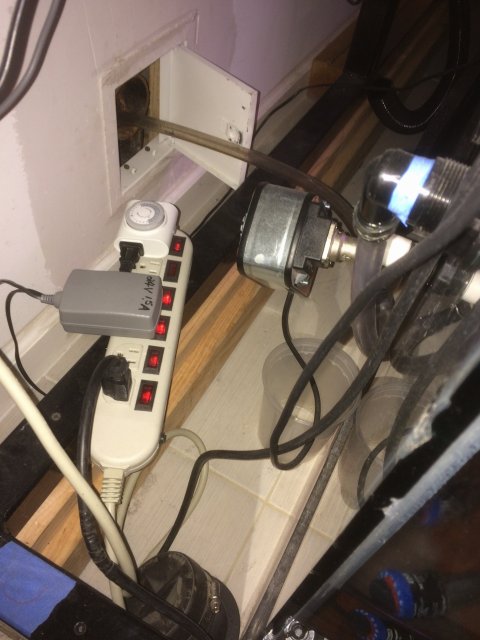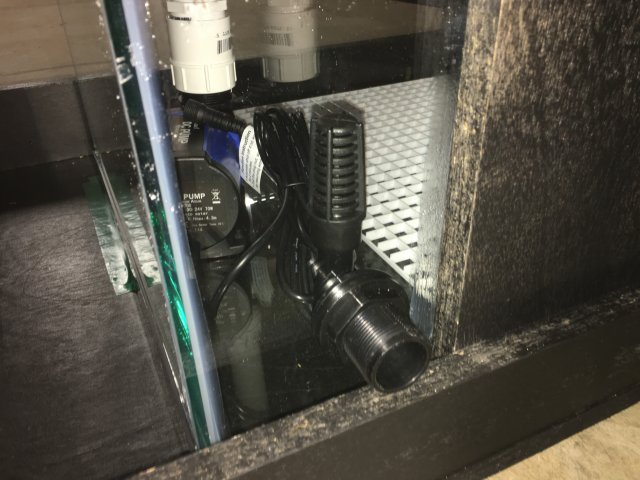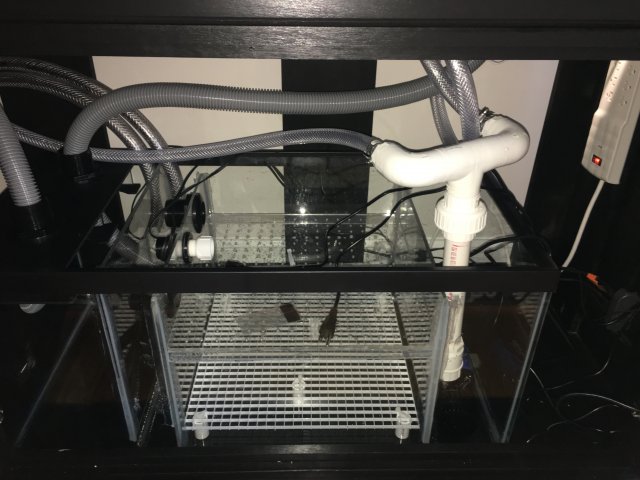Drip automatic water change system with sump filter
- Thread starter Galc
- Start date
Regular sump filter without drip system needs additional space for water in case of return pump fails.
If I understand with drip system this additional space in sump is always filled with water if return pump operate or not. And drain pipe is installed above that additional space in sump. So in case of return pump failure all excess water will mainly go to drain, but in sump will be enough water for sump to work. Right?
If I understand with drip system this additional space in sump is always filled with water if return pump operate or not. And drain pipe is installed above that additional space in sump. So in case of return pump failure all excess water will mainly go to drain, but in sump will be enough water for sump to work. Right?
You just need to drill the sump high enough to contain the overflow but not low enough for the pump to run dry.
View attachment Sump pic.jpg
View attachment Sump pic.jpg
If I understand your post, I think you have the general idea.Regular sump filter without drip system needs additional space for water in case of return pump fails.
If I understand with drip system this additional space in sump is always filled with water if return pump operate or not. And drain pipe is installed above that additional space in sump. So in case of return pump failure all excess water will mainly go to drain, but in sump will be enough water for sump to work. Right?
With a drip system, you plan to have over flows since you are constantly adding water. You simply have to pick how and where you over flow. I haven't run a drip system, but my preference would be to overflow the sump directly into a floor drain. I'm sure there are many other options and methods, and some might be superior to the one I like.
With a non-drip sump system, you don't keep adding water, and you don't want any unplanned overflows since unplanned overflows can end up pretty much anywhere (like the floor.)
In my mind, the extra sump capacity can allow the entire system to shut down and let "in process water" (water in the overflow box, water above the tank overflow line, and potentially water in the pipes and tubes and not in the sump or tank) to all go to the sump without overflowing. Set up correctly, this should be fail proof, although again bad things can happen.
Also, just to be clear, this assumes the sump is below the tank, which isn't always the case, and it assumes the tank is truly over flowing, and not siphoning (down a tube or through a bottom vent.) In those cases, the above would be very different.
Maybe I've made some mistakes in explaining this, but hopefully it's clear and correct.
Last edited:
My situation is the same as you. I got a little lost at first with my drip. Than I figured it all out. Just know how much water you'll like to keep in the sump but if you don't want too much. You'll need an automatic shut off valve when pump shuts off when power outage. Or pick a level where ur pump still won't run dry when power is turn on or return of electricity. The 1st scenario I did it that way since I like my sump water to not over flow to the last baffle line. I drill the sump and added bulkhead drain at that height than I added another another bulkhead about 3" below the sump tank overall height so if power outage and no one home to shut the drip than the water would fill till it over flows to the top drain and bypass the automatic shut off valve that's about 10" below the emergency drain. Hope picture will help explain my situation.


In my opinion you should drill the sump in the same chamber as your pump is going to be. Drill and install a bulkhead just at the height that the return pumps inlet will be. You can put a 90 on the bulkhead and use a piece of pipe going upwards. The pipe will actually act as your water line in your sump. Increase or decrease then length to your liking. 



I read that like 5 times and i have no idea what you are trying to describe........As long as you have a drain in your sump you do not have to worry about overflowing it during a poweroutageMy situation is the same as you. I got a little lost at first with my drip. Than I figured it all out. Just know how much water you'll like to keep in the sump but if you don't want too much. You'll need an automatic shut off valve when pump shuts off when power outage. Or pick a level where ur pump still won't run dry when power is turn on or return of electricity. The 1st scenario I did it that way since I like my sump water to not over flow to the last baffle line. I drill the sump and added bulkhead drain at that height than I added another another bulkhead about 3" below the sump tank overall height so if power outage and no one home to shut the drip than the water would fill till it over flows to the top drain and bypass the automatic shut off valve that's about 10" below the emergency drain. Hope picture will help explain my situation.
View attachment 1249888
Right, I'd be more worried about being short of water in the sump when the tank begins to refill. This can be easy to deal with by making sure you have siphon breaks on the returns or by positioning the outputs close to surface level. That way it won't back siphon too much into the sump.I read that like 5 times and i have no idea what you are trying to describe........As long as you have a drain in your sump you do not have to worry about overflowing it during a poweroutage





